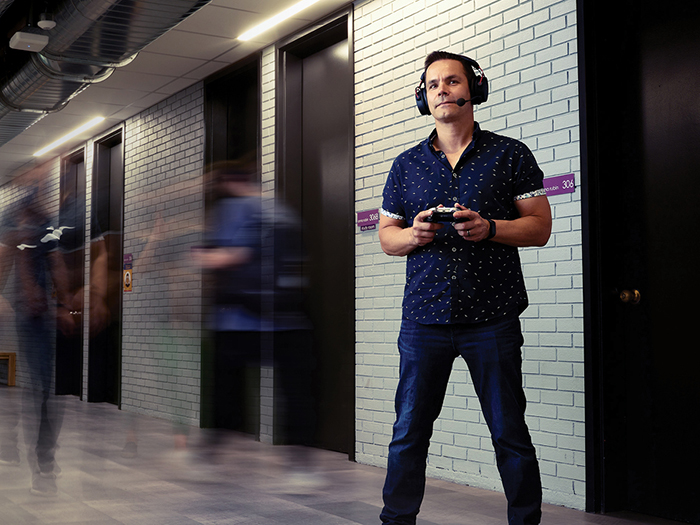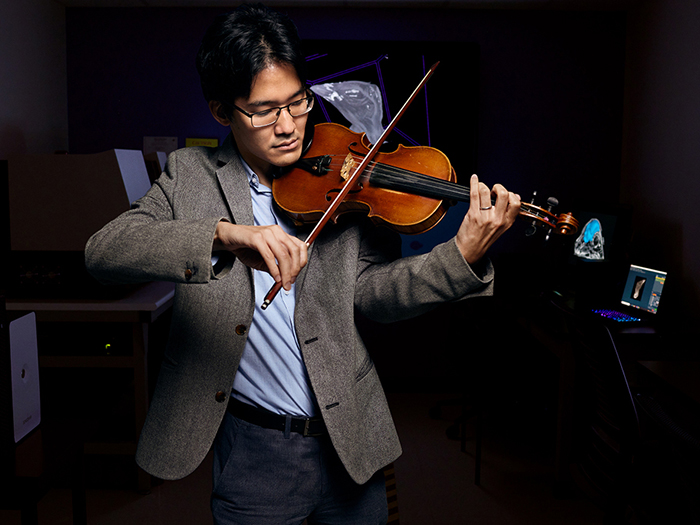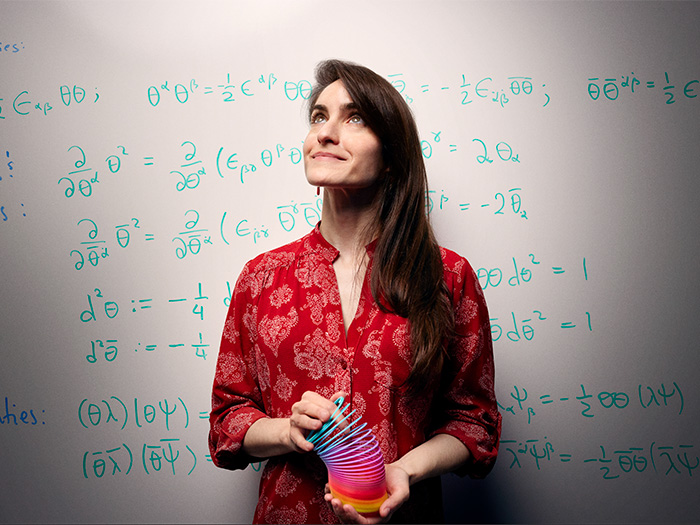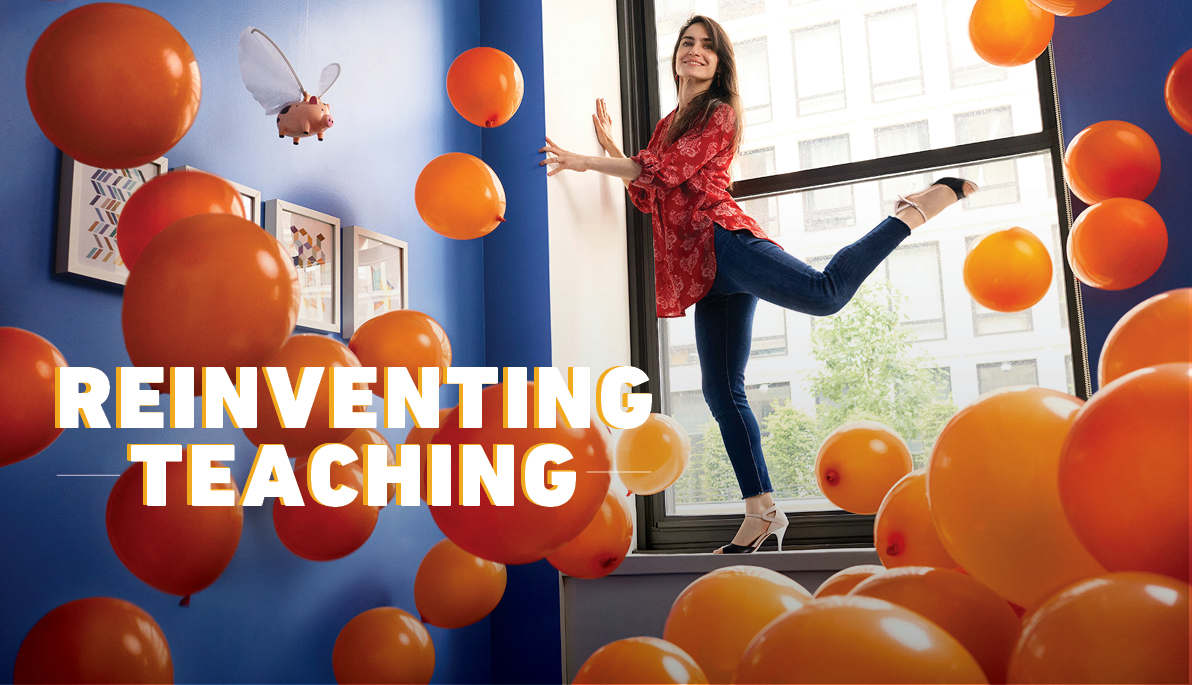News
Innovative Approaches to Learning Make an Impact
March 10, 2022
New York Tech professors get creative, using seemingly unrelated topics and tactics to connect with students.
Finding ways to teach complicated subjects has always been a challenge for educators. But it’s even more difficult today: Science has become more polarizing, and, as mainstream Hollywood depicted in the satirical movie, Don’t Look Up, it’s questioned and denied by many members of society. With so much information—not all of it reliable—available with just a few keystrokes and a good Internet connection, finding new strategies to help students learn to distill and comprehend difficult aspects of both science and the humanities takes a special talent.
To help engage the disengaged in complicated subject matter, four New York Institute of Technology faculty members have incorporated unconventional approaches in their teaching and scholarship, including improvisation, video games, and popular culture.
Marrying the Virtual World with Science and Literature
William Shakespeare’s Hamlet is a requisite in many literature classes, but students often get lost in the vernacular. And, on the other side of the academic spectrum, concepts in physics, biology, and anatomy can be equally as challenging.
While Shakespeare and video games are not a standard pairing, John Misak, assistant professor of humanities, and a former colleague recently developed an augmented reality game, Perchance: An AR Hamlet Mystery, after they noticed their students’ lack of engagement with Hamlet.
 John Misak, Assistant Professor of Humanities, Photographed by Rick Wenner.
John Misak, Assistant Professor of Humanities, Photographed by Rick Wenner.
Misak saw a unique opportunity to take his passion for gaming to the next level while enhancing his students’ learning experience. He taught himself basic coding and animation techniques, then recruited undergraduate computer science students to integrate advanced technology into his new-age approach to literature.
“If you can make fun of something, then that means you understand it.”
Assistant Physics Professor, Eve Armstrong
Since then, a mystery component has been added and improvements have been made. “Students indicated a preference for a traditional game with AR sprinkled in,” he says.
Akinobu “Aki” Watanabe, Ph.D., assistant professor of anatomy in New York Tech’s College of Osteopathic Medicine, is taking his research into the virtual realm. As part of a National Science Foundation Faculty Early Career Development Program (CAREER) award, he is integrating virtual reality (VR) into his world—an ideal marriage because of the 3-D aspects of anatomy that VR can convey.
Watanabe is developing a fun learning experience that combines birding and anatomy. In the program he proposes, people match bird skulls with bird brains to highlight differences between species and their brain sizes and skulls. When there’s a match, the player “collects” the bird—similar to how birders collect the birds they see—and learns more about the species. His target audience is middle and high school students and, through this program, he also hopes to make science more inclusive.
“Science is overwhelmingly communicated through a combination of sound and images, which tend to exclude individuals who are deaf and/or blind,” he explains. “The VR experience is an immersive, portable way to engage individuals who are deaf as well as possibly developing a similar game for people who are blind.”
 Akinobu “Aki” Watanabe, Ph.D., Photographed by Rick Wenner.
Akinobu “Aki” Watanabe, Ph.D., Photographed by Rick Wenner.
And just as Misak brought art to technology, Watanabe—who minored in music during his undergraduate years—plans to integrate science to create a musical composition using scientific data. He notes that while there are compositions in music and dance inspired by science, he will use data and metrics to guide the musical composition. For example, he will transform the diversity of anatomical structures and shapes into the pitch and geological time into the beat. Ultimately, Watanabe hopes to debut his score with the help of a string quartet.
Communicating Science
While Misak and Watanabe are leveraging the virtual realm to reframe their disciplines, Sophia Domokos, Ph.D., and Eve Armstrong, Ph.D., both assistant professor of physics, are taking different approaches to help students improve their science communication skills.
For one, Domokos’s simple yet nontraditional method of allowing students to work together to solve physics problems has yielded positive results. Students learn to collaborate on a high level as they tackle problems and communicate their findings. “It’s very important for scientists to be able to communicate about their work,” Domokos says. “Also, learning how to communicate about your subject is integral to actually understanding it deeply.”
“Although the media tend to be brushed aside as distractions, they are a constant source of fresh ideas for me when it comes to how I approach and communicate my research.”
Assistant Professor of Anatomy, Akinobu “Aki” Watanabe, Ph.D.
Domokos also makes a point of incorporating real-world physics problems into her lectures, some of which are practical while others are pure fun. For instance, to teach static electricity, she has students rub balloons on their heads to show how electrical charges transfer to the balloons, which then creates “this cool effect, kind of like Van der Graaf generator, crazy scientist hair,” Domokos explains.
Domokos also finds unexpected lessons in science communication as she practices dancing the Argentine Tango. “The instructor tells you what you’re supposed to be doing with your body, and you’re trying to make it happen with your brain, but it’s just not happening,” she says. This experience has helped her understand students who are learning new concepts. “It takes some time to incorporate a new skill, and physics is really a new way of using your brain.”
 Sophia Domokos, Ph.D., Photographed by Rick Wenner.
Sophia Domokos, Ph.D., Photographed by Rick Wenner.
Together with Armstrong, who is also a research associate at the American Museum of Natural History, Domokos organized the Math and Physics Student Research Symposium, a program giving New York Tech students an opportunity to present their work in physics and math.
“We started this program because knowing how to give a talk is a key skill for any scientist,” said Domokos. “It’s often through talks that other scientists first learn about your work. Explaining research to others is also a great way to understand it better yourself.”
Science as Entertainment
Armstrong also brings a bit of theater and art into the classroom mix. Before she finished her Ph.D., she and her now-husband started Reality Aside Theatre, developing science education sketch comedy and performing at schools.
And while Armstrong stepped away from the theater to finish her doctorate, she has not abandoned it. When the pandemic hit in 2020 and classrooms went virtual, she incorporated improv techniques to help students connect. Notes Armstrong: “Everyone is afraid to make mistakes or ask a stupid question, but improv games are intended to get people to be as ridiculous as you possibly can.” While she was initially nervous about how students would react, they took to it well.
“Explaining research to others is also a great way to understand it better yourself.”
Assistant Physics Professor, Sophia Domokos, Ph.D.
She points out that the improv games are not just about making classes more interesting. For Armstrong, it’s important to foster engagement between students because “it’s really, really hard to learn alone. Science itself is a collaborative endeavor, and you work with other researchers.”
Armstrong also likes to bring satire and parody into her work and recently wrote an article parodying machine learning. She uses this technique in the classroom and assigned her summer research students to do both a scientific writeup and a spoof of their work: “If you can make fun of something, then that means you understand it.”
Inserting humor into science is “kind of like tricking people into learning something. Making them loosen up, making them laugh. It just makes learning easier and more enjoyable,” Armstrong explains.
Whether it’s using VR or AR, satire or staged improv, these innovative educators inspire their peers and students at New York Tech to make creative connections with their disciplines and each other. Domokos sums up why it’s important to do things just a little bit differently: “What’s important is to engage students [and the general public in] learning strategies to help them learn new skills.”




